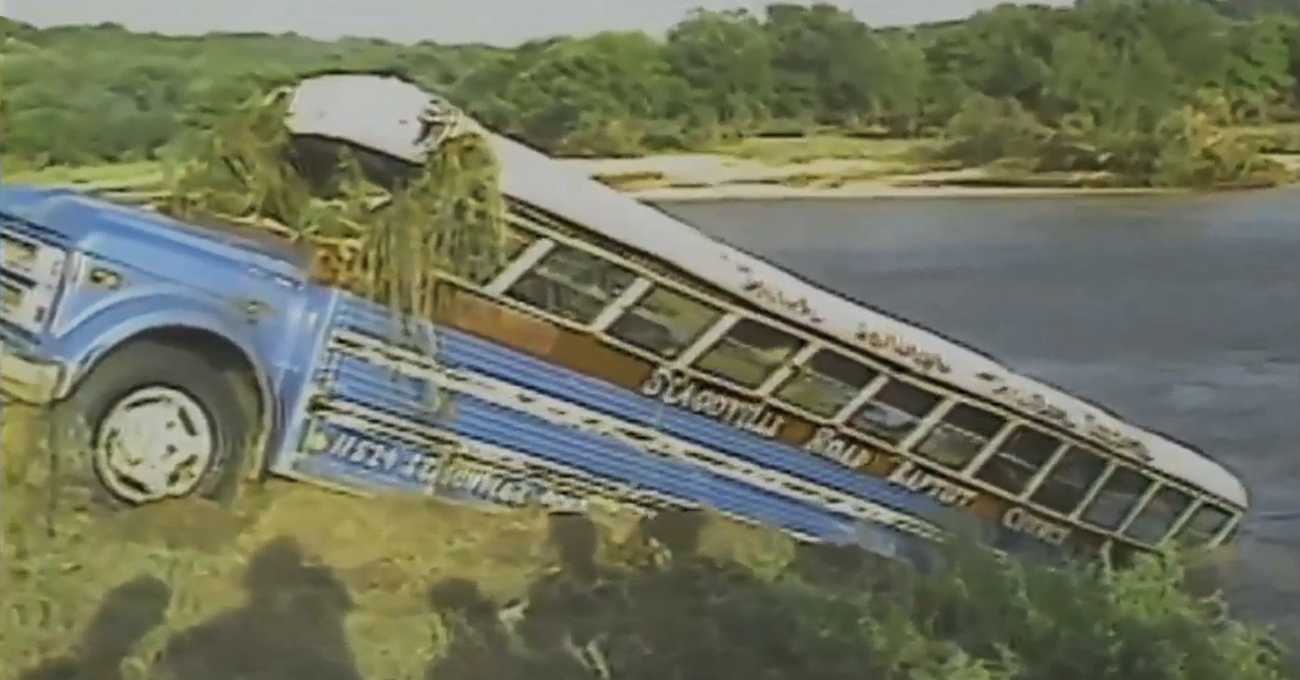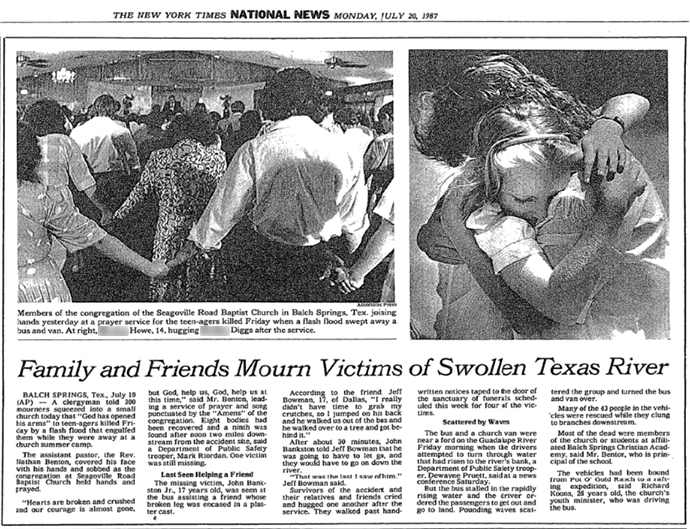‘Unprecedented’? I Watched as Friends Were Swept Away in a Devastating Guadalupe River Flood – in 1987

The flooding in Texas has been catastrophic, terrifying, deadly. Forty-eight are reported dead, 15 of them children, with more missing from a summer camp along the Guadalupe river. With search, rescue, and recovery operations still underway, and the total scope of the disaster not yet known, it is already an immense tragedy. “Unprecedented,” to use the words of news reports and reactions around the country.
But there is another word that comes to mind for some of us watching the last few days of coverage showing the dark waters, the anguished faces, and the desperate search and rescue efforts in Texas: familiar. They are hauntingly and despairingly familiar to many of us who lived in Texas in the 1980s. Because this, tragically, has happened before.
In 1987 my sister was a student at the Balch Springs Christian Academy at Seagoville Road Baptist Church. Just seeing those names typed out evokes a strong reaction for me, inundating me with memories of the week when children we knew and loved were killed in an incomprehensible tragedy that unfolded live on local television.
My sister lost her best friend. Parents lost children. Siblings lost siblings. Friends lost friends. It was hard to take in and understand then, and it’s hard to watch the coverage now that feels like reliving that horror all over again.

This writer’s sister, pictured in a 1987 New York Times article on the Seagoville Road bus tragedy.
In 1987, the Balch Springs Christian Academy had a group of students at Summer Camp down near Comfort, Texas. After the week of fun and celebration of Christian faith, heavy rainfall upriver was already causing major flooding. It was the last day at Pot O’ Gold Ranch for the campers, and the decision had been made early that morning to evacuate the area.
The image of the Seagoville Road Baptist Church bus is one that will never leave the many hundreds of people who were affected by what happened next. The group from Balch Springs, which included the pastor, chaperones, and thirty-nine children from ages 8 to 17 were the last to leave. The bus and two other vehicles attempted to leave the area and bring the children home to their families. But the engine flooded and died in the water rushing over the tiny road they were using to cross an area that was once a channel of the river.
The pastor made the decision to get the children out of the vehicle and form a human chain to cross the remainder of the way over the rapidly rising water. As the children, arms linked, were spread across the road, a wall of water rushed upon them and, in an instant, they were washed down the river and into the flood.
As news of the events unfolding spread, television stations began airing live shots from the area. Many local stations had helicopters in the air already to cover the flooding.
This meant that, as we watched from home in Dallas, we saw in the floodwaters children from my sister’s school, from that tiny and familiar church of friends and neighbors in that small suburban community. We saw them clinging to trees, trying to escape. We saw some fail and continue to be swept down the river by the flood. We saw them being plucked from trees and rescued – and horribly, we saw failed rescue attempts, with people plunging from the harness or the hands of rescuers down into the water, some never to be seen alive again.
The first confirmed death in the accident was 14-year-old Melanie Finley, whose fall was aired live by local news that horrible day. Back in July of 1987 I was just 12 years old. My sister was 14. Her best friend Tonya Smith, just 13 at the time, was the second confirmed fatality her body discovered caught in barbed wire some two miles down from where they were first struck. Tonya’s sister Stacey Smith, 16-years-old, was soon after confirmed among those who died.
The body of 17-year-old John Bankston Jr., the last among the list of fatalities, was never recovered. He died rescuing a fellow student from the floodwaters, who survived the ordeal thanks to Bankston.
In news reports on Friday and Saturday, as well as in statements from public officials, I keep hearing the word “unprecedented” to describe the terrible, ongoing tragedy in Texas. And of course, the scope and magnitude of this disaster are, in that sense, unprecedented.
But the deaths of promising young lives to massive flooding along the Guadalupe River near Comfort, Texas is not unprecedented in terms of trauma, tragedy, sadness, or loss.
The echoes of the Seagoville Road Baptist Church bus tragedy may seem like an historical oddity to those observing the similarities today. But the pain that was experienced by everyone affected by the monumentally horrific and world-changing events of July, 1987 were and are a very real and catastrophic tragedy. It will never seem less than that.
I am filled with pain and sorrow for the families going through this nightmare today in Texas. I’m offended by the callous political blustering I’ve seen on X over this.
But most of all, I just can’t believe it’s all happening again. In the face of such a monstrous horror, I feel like I’m a child once again, helpless to do anything but watch and despair — and pray. I am praying every few minutes. I am praying with you and for you. I hope some day there is some comfort in knowing how many people are doing the same.
The post ‘Unprecedented’? I Watched as Friends Were Swept Away in a Devastating Guadalupe River Flood – in 1987 first appeared on Mediaite.
from Mediaite https://ift.tt/doCRmJ2



0 comments